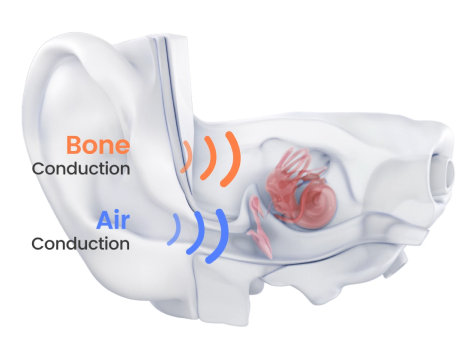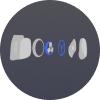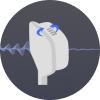Bone conduction is one of the ways we perceive sound. While the most common method of hearing is through air conduction, where sound waves travel through the air to reach the eardrum, bone conduction involves the transmission of sound vibrations through the bones of our skull and inner ear.
It’s difficult for the average individual to distinguish sound being conveyed through the bone as opposed to the sound being conveyed through the air via the ear canal, but here’s a simplified explanation of how we experience it every day.
Sound Waves
Sound waves are created when an object vibrates, such as when a person speaks, music plays, or any other sound-producing activity occurs. These sound waves consist of compressions and rarefactions of air particles, which travel through the medium (usually air) as a series of waves.
Transmission
Air Conduction
Bone Conduction
Mechanism
Audiogram

Shokz made bone conduction technology mainstream.
Shokz persevered to solve typical criticisms about bone conduction audio, amassing hundreds of patents and numerous awards in the process.
Hear what World Intellectual Property Organization (WIPO) says about Shokz inventions.
"It’s easy to see that the open-ear design of bone conduction headphones is more comfortable and allows natural connectivity with surroundings. Many companies such as Motorola, 3M, Docomo, Panasonic and Vonia attempted to build bone conduction headphones before Shokz (formerly AfterShokz). They found it to be a daunting task, and none of them were successful.“
It took Shokz a decade to overcome numerous obstacles, and in the process a number of proprietary technologies were invented:

PremiumPitch: to achieve balanced audio from bass to high pitch.

LeakSlayer: to minimize sound leakage generated vibrations. After 4-5 generations of products and continuous improvements, customers are finally happy.

TitaniumFit: the precise contact with cheekbones is crucial to audio and comfort. Shokz started to use a titanium memory alloy frame a decade ago.

TurboPitch: while bone conduction is great at expressing mid and high frequency, bone conduction bass is limited to contain vibration feeling. TurboPitch recycles bass vibration with an acoustic membrane and feed the bass sound back to ear.
Many generations of Shokz products won prestigious awards around the world.




- the CES Technology Innovation Award (in 2020, 2019, 2017, 2014 and 2013);
- the EDISON Gold Award (2014);
- the Yicai Global China Best Inventions Award (2017);
- the IDEA Bronze Award (2015);
- the Good Design Award (in 2020, 2019, 2017 and 2016);
- the Reddot Design Award (in 2021 and 2018);
- the IF Award (in 2021 and 2020);
User experience continues to drive the growth of the bone conduction headphone category.
30,000+
stores with demo stations15,000,000+
sports headphones and counting.Word of mouth has been the primary driver of Shokz brand awareness. People all over the world have experienced our products in one of the 30,000 in-store demo stations found in retail locations around the world. Since 2011, we’ve sold more than 15,000,000 sports headphones and counting.
Bone conduction headsets are more comfortable and real-world connected.
All Shokz bone conduction headphones and headsets are designed to deliver audio via mini vibrations on the cheekbones, which allows ears to remain completely uncovered and unplugged. Open-ear comfort is especially helpful to professional headsets users who wear headsets for an average of four hours each day.



